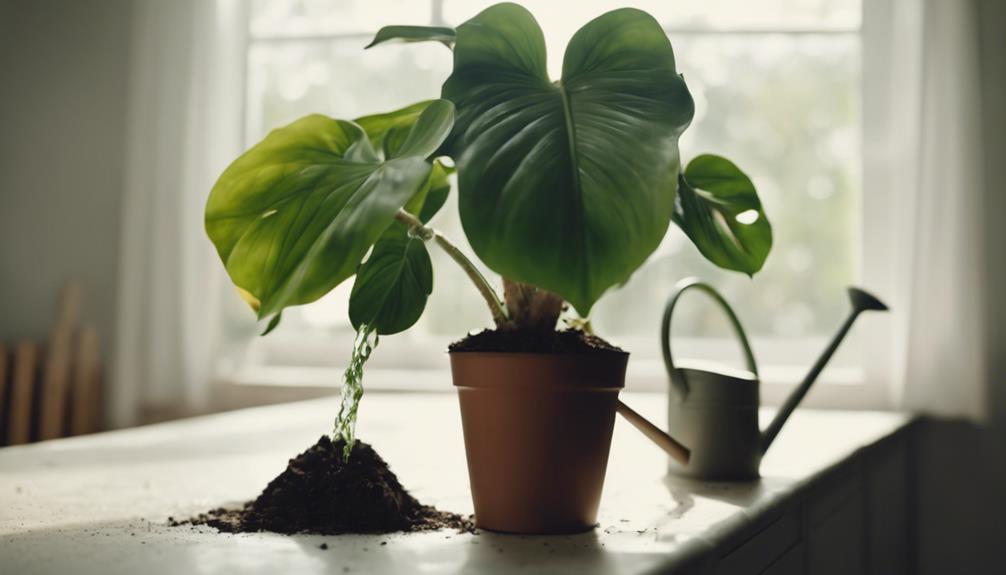Understanding the Unique Needs of Your Fiddle Leaf Fig
The Fiddle Leaf Fig (Ficus lyrata) has become a staple in modern home decor, prized for its stylish, violin-shaped leaves and ability to thrive in indoor environments. However, this popular houseplant has specific watering needs that must be met to ensure optimal health and growth. Native to the tropical regions of West Africa, the Fiddle Leaf Fig is adapted to a humid, warm climate with ample rainfall. As a result, it requires careful attention to its watering schedule to prevent over- or under-watering.
When considering how often to water a Fiddle Leaf Fig, it’s essential to strike the right balance. Over-watering can lead to root rot, while under-watering can cause the leaves to become dry and brittle. To avoid these common mistakes, it’s crucial to understand the unique needs of your Fiddle Leaf Fig and adjust its watering schedule accordingly. By doing so, you’ll be able to provide your plant with the perfect amount of moisture to thrive.
So, how often should you water your Fiddle Leaf Fig? The answer depends on various factors, including the plant’s size, potting mix, and environment. In general, a Fiddle Leaf Fig prefers to dry out slightly between waterings, but the frequency of watering will vary depending on the specific conditions. By monitoring your plant’s response to watering and adjusting its schedule as needed, you’ll be able to provide the perfect amount of moisture to support healthy growth and development.
In the next section, we’ll explore the different methods for checking soil moisture, including the finger test, moisture meter, and lifting the pot. By mastering these techniques, you’ll be able to determine the optimal watering schedule for your Fiddle Leaf Fig and ensure it receives the right amount of moisture to thrive.
How to Check the Moisture Levels of Your Fiddle Leaf Fig’s Soil
Checking the moisture levels of your Fiddle Leaf Fig’s soil is crucial to determining how often to water your plant. There are several methods to check soil moisture, each with its own benefits and drawbacks. By mastering these techniques, you’ll be able to provide your Fiddle Leaf Fig with the right amount of water to thrive.
The finger test is a simple and effective way to check soil moisture. To perform the finger test, insert your finger into the soil up to the first knuckle. If the soil feels dry, it’s time to water your Fiddle Leaf Fig. If the soil feels moist, wait a few more days before checking again. This method is especially useful for Fiddle Leaf Figs that are still getting established in their pots.
Another method for checking soil moisture is to use a moisture meter. A moisture meter is a handy tool that measures the moisture levels in the soil. Simply insert the probe into the soil, and the meter will give you a reading of the moisture levels. This method is especially useful for Fiddle Leaf Figs that are sensitive to over-watering.
Lifting the pot is another way to check soil moisture. This method involves lifting the pot and checking the weight. A dry pot will be much lighter than a pot with moist soil. This method is especially useful for Fiddle Leaf Figs that are in large pots or for those who are new to caring for Fiddle Leaf Figs.
Regardless of the method you choose, it’s essential to check the soil moisture regularly to ensure your Fiddle Leaf Fig is receiving the right amount of water. By doing so, you’ll be able to avoid over-watering and under-watering, which can lead to a range of problems, including root rot and leaf drop.
In the next section, we’ll explore the various factors that affect how often to water a Fiddle Leaf Fig, including temperature, humidity, light exposure, pot size, and time of year. By understanding these factors, you’ll be able to provide your Fiddle Leaf Fig with the perfect amount of water to thrive.
The Factors That Influence Your Fiddle Leaf Fig’s Watering Schedule
When it comes to determining how often to water a Fiddle Leaf Fig, several factors come into play. Understanding these factors is crucial to providing your plant with the right amount of water to thrive. In this section, we’ll explore the various factors that affect a Fiddle Leaf Fig’s watering schedule, including temperature, humidity, light exposure, pot size, and time of year.
Temperature is one of the most significant factors that affect a Fiddle Leaf Fig’s watering schedule. In general, Fiddle Leaf Figs prefer temperatures between 65-75°F (18-24°C). When the temperature is higher, the plant will require more water to compensate for the increased evaporation. Conversely, when the temperature is lower, the plant will require less water.
Humidity is another critical factor that affects a Fiddle Leaf Fig’s watering schedule. Fiddle Leaf Figs prefer a relatively high humidity, typically above 50%. When the humidity is low, the plant will require more water to compensate for the increased moisture loss. Conversely, when the humidity is high, the plant will require less water.
Light exposure is also an essential factor that affects a Fiddle Leaf Fig’s watering schedule. Fiddle Leaf Figs prefer bright, indirect light. When the plant is exposed to direct sunlight, it will require more water to compensate for the increased evaporation. Conversely, when the plant is exposed to low light, it will require less water.
Pot size is another factor that affects a Fiddle Leaf Fig’s watering schedule. In general, smaller pots will require more frequent watering than larger pots. This is because smaller pots have a smaller soil volume, which means the soil will dry out faster.
Finally, the time of year is also an essential factor that affects a Fiddle Leaf Fig’s watering schedule. During the spring and summer months, Fiddle Leaf Figs require more water due to the increased growth rate. Conversely, during the fall and winter months, Fiddle Leaf Figs require less water due to the slower growth rate.
By understanding these factors, you’ll be able to adjust your Fiddle Leaf Fig’s watering schedule accordingly. In the next section, we’ll provide a general outline for watering a Fiddle Leaf Fig, including the frequency and amount of water to use.
A General Watering Schedule for Your Fiddle Leaf Fig
Now that we’ve discussed the various factors that affect a Fiddle Leaf Fig’s watering schedule, let’s provide a general outline for watering your plant. Keep in mind that this is just a general guideline, and you’ll need to adjust the schedule based on the specific factors mentioned earlier.
As a general rule, Fiddle Leaf Figs prefer to be watered once a week during the spring and summer months when they’re actively growing. During the fall and winter months, you can reduce watering to once every 10-14 days. However, this frequency may vary depending on the temperature, humidity, and light exposure your plant is receiving.
When watering your Fiddle Leaf Fig, make sure to use room-temperature water and avoid getting water on the leaves. Watering at the base of the plant will help prevent fungal diseases and ensure the roots receive the right amount of moisture.
The amount of water to use will also depend on the size of your Fiddle Leaf Fig. A general rule of thumb is to water your plant until you see water coming out of the drainage holes. This will ensure the soil is moist but not waterlogged.
It’s also essential to check the soil moisture before watering your Fiddle Leaf Fig. You can use one of the methods mentioned earlier, such as the finger test or moisture meter, to determine if the soil is dry or moist. If the soil is already moist, you can skip watering for that day.
By following this general watering schedule and adjusting it based on the specific factors mentioned earlier, you’ll be able to provide your Fiddle Leaf Fig with the right amount of water to thrive.
In the next section, we’ll offer tips on how to water your Fiddle Leaf Fig for optimal health, including the use of a well-draining potting mix and a pot with good drainage holes.
How to Water Your Fiddle Leaf Fig for Optimal Health
Watering your Fiddle Leaf Fig is an art that requires attention to detail and a understanding of the plant’s specific needs. To ensure your Fiddle Leaf Fig receives the right amount of water, follow these tips:
Use room-temperature water: Avoid using cold or hot water, as this can shock the roots and cause damage to the plant. Room-temperature water is ideal for Fiddle Leaf Figs, as it allows for optimal absorption and minimizes the risk of root rot.
Avoid getting water on the leaves: While it may be tempting to water your Fiddle Leaf Fig by spraying the leaves, this can lead to fungal diseases and other problems. Instead, water at the base of the plant, allowing the soil to absorb the moisture.
Ensure good drainage: Fiddle Leaf Figs prefer well-draining soil and pots with good drainage holes. This allows excess water to escape, preventing waterlogged soil and root rot.
Use a well-draining potting mix: A well-draining potting mix is essential for Fiddle Leaf Figs, as it allows for optimal water absorption and prevents waterlogging. Look for a potting mix that contains ingredients like perlite, vermiculite, or sand, which improve drainage and aeration.
Water thoroughly: When watering your Fiddle Leaf Fig, make sure to water thoroughly until you see water coming out of the drainage holes. This ensures the soil is moist but not waterlogged.
By following these tips, you’ll be able to provide your Fiddle Leaf Fig with the right amount of water to thrive. Remember to adjust your watering schedule based on the specific factors mentioned earlier, such as temperature, humidity, and light exposure.
In the next section, we’ll discuss common mistakes to avoid when watering your Fiddle Leaf Fig, including over-watering, under-watering, and getting water on the leaves.
Common Mistakes to Avoid When Watering Your Fiddle Leaf Fig
When it comes to watering your Fiddle Leaf Fig, there are several common mistakes to avoid. By being aware of these mistakes, you can ensure your plant receives the right amount of water and thrives.
Over-watering is one of the most common mistakes people make when watering their Fiddle Leaf Fig. This can lead to root rot, yellowing leaves, and a range of other problems. To avoid over-watering, make sure to check the soil moisture regularly and adjust your watering schedule accordingly.
Under-watering is another common mistake that can cause problems for your Fiddle Leaf Fig. This can lead to dry, brittle leaves and a range of other issues. To avoid under-watering, make sure to water your plant thoroughly and regularly, taking into account the specific factors that affect its watering needs.
Getting water on the leaves is another mistake to avoid when watering your Fiddle Leaf Fig. This can lead to fungal diseases and other problems, so make sure to water at the base of the plant and avoid getting water on the leaves.
Not adjusting the watering schedule based on the specific factors that affect the plant’s watering needs is another common mistake. By taking into account the temperature, humidity, light exposure, pot size, and time of year, you can ensure your Fiddle Leaf Fig receives the right amount of water and thrives.
By avoiding these common mistakes, you can ensure your Fiddle Leaf Fig receives the right amount of water and thrives. In the next section, we’ll discuss the importance of monitoring your Fiddle Leaf Fig’s response to watering and adjusting the schedule accordingly.
Monitoring Your Fiddle Leaf Fig’s Response to Watering
Monitoring your Fiddle Leaf Fig’s response to watering is crucial to ensuring it receives the right amount of water. By observing your plant’s response to watering, you can adjust the schedule accordingly and prevent over- or under-watering.
One of the most common signs of over-watering is yellowing leaves. If you notice your Fiddle Leaf Fig’s leaves turning yellow, it may be a sign that the plant is receiving too much water. On the other hand, if the leaves are droopy or wilted, it may be a sign that the plant is not receiving enough water.
Another way to monitor your Fiddle Leaf Fig’s response to watering is to check the soil moisture regularly. By using one of the methods mentioned earlier, such as the finger test or moisture meter, you can determine if the soil is dry or moist. If the soil is dry, it may be time to water your plant. If the soil is moist, you can wait a few more days before watering again.
It’s also important to observe your Fiddle Leaf Fig’s overall health and adjust the watering schedule accordingly. If your plant is looking healthy and thriving, it may be a sign that the watering schedule is working. On the other hand, if your plant is looking stressed or struggling, it may be a sign that the watering schedule needs to be adjusted.
By monitoring your Fiddle Leaf Fig’s response to watering and adjusting the schedule accordingly, you can ensure your plant receives the right amount of water and thrives. In the next section, we’ll discuss how to adjust the watering schedule for different seasons and conditions.
Adjusting Your Watering Schedule for Different Seasons and Conditions
As the seasons change, your Fiddle Leaf Fig’s watering needs will also change. It’s essential to adjust your watering schedule to accommodate these changes and ensure your plant receives the right amount of water.
During the winter months, Fiddle Leaf Figs require less water due to the cooler temperatures and reduced humidity. Reduce watering to once every 10-14 days, and make sure the soil is not too wet or dry.
In the spring and summer months, Fiddle Leaf Figs require more water due to the warmer temperatures and increased humidity. Increase watering to once every 7-10 days, and make sure the soil is consistently moist but not waterlogged.
During periods of high humidity, Fiddle Leaf Figs require more water to compensate for the increased moisture in the air. Increase watering to once every 5-7 days, and make sure the soil is consistently moist but not waterlogged.
In areas with low humidity, Fiddle Leaf Figs require less water to prevent over-watering. Reduce watering to once every 10-14 days, and make sure the soil is not too wet or dry.
It’s also essential to adapt to changes in temperature, light exposure, and other environmental factors. For example, if your Fiddle Leaf Fig is exposed to direct sunlight, it may require more water to prevent scorching. If your Fiddle Leaf Fig is exposed to cold temperatures, it may require less water to prevent root rot.
By adjusting your watering schedule to accommodate the changing seasons and conditions, you can ensure your Fiddle Leaf Fig receives the right amount of water and thrives.
Advanced Tips for Fiddle Leaf Fig Care
For experienced plant enthusiasts, here are some advanced tips for taking your Fiddle Leaf Fig care to the next level.
Pruning: Prune your Fiddle Leaf Fig regularly to maintain its shape and promote healthy growth. Remove any dead or damaged leaves, and cut back any overgrown branches to maintain a balanced shape.
Fertilization: Fertilize your Fiddle Leaf Fig during the growing season (spring and summer) with a balanced fertilizer. This will provide essential nutrients for healthy growth and development.
Pest control: Check your Fiddle Leaf Fig regularly for signs of pests, such as spider mites, mealybugs, or scale. Use organic pest control methods whenever possible, and avoid using chemical pesticides that can harm your plant.
Repotting: Repot your Fiddle Leaf Fig every 1-2 years to provide fresh potting mix and a larger pot if necessary. This will give the roots more room to grow and help prevent root bound.
Propagation: Propagate your Fiddle Leaf Fig by taking stem cuttings or leaf cuttings. This will allow you to share your plant with friends and family, or create new plants for yourself.
By following these advanced tips, you can take your Fiddle Leaf Fig care to the next level and enjoy a thriving and healthy plant.








